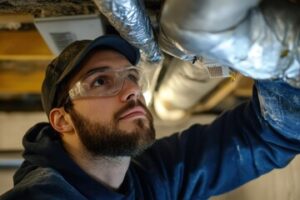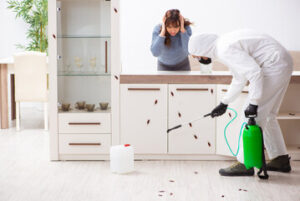Air Duct Cleaning involves the use of powerful vacuums that remove dust and contaminants from inside your home’s ductwork. Professionals may also use brushes or compressors to dislodge stubborn debris. Before they arrive, you should move any furniture or other objects that may be in their way.

Dirty ducts breed bacteria, pet dander, mold spores and mildew. These allergens then get blown back into your living spaces, causing breathing issues. A thorough cleaning eliminates these irritants. Visit https://www.allproutah.com to learn more.
Over the years, ductwork systems tend to accumulate sizeable deposits of dirt and dust. These deposits act as a breeding ground for organisms like dust mites, which can trigger allergies and breathing troubles in susceptible people. Vacuuming, cleaning and changing the filters can help reduce dust in the home but a thorough air duct cleaning is often needed to get rid of it entirely.
Dirty ductwork also traps odors like those caused by pets, household cleaning agents, paint fumes, tobacco use and food preparation. These odors are then circulated throughout the home each time the furnace or AC runs, creating a musty smell. A professional duct cleaning removes these odors from the system, eliminating their lingering effects and leaving your house with a fresher scent.
If left unchecked, a buildup of dirt and grime in the ductwork can restrict the flow of hot and cool air, which can reduce HVAC efficiency by up to 30%. A thorough duct cleaning eliminates these obstructions, allowing the air to move freely and improving your system’s energy efficiency.
Duct leakage is another common issue that can significantly affect your HVAC system’s performance and the overall quality of your indoor air. Leaky ducts can draw in outside air, leading to higher heating and cooling bills and a dusty environment in the living spaces. A thorough duct inspection and cleaning should include testing for duct leakage as well as checking for visible signs of damage or wear.
In addition to cleaning out the physical debris from your ductwork, NADCA-certified technicians can also apply a sanitizer to your ductwork to kill microorganisms like bacteria and mildew. This service is ideal for homes with young children and elderly individuals who may be more sensitive to these harmful contaminants.
Reduced Allergens & Irritants
Air ducts can become the repository for allergens, dust and pollutants that then circulate throughout the home. Duct cleaning eliminates these irritants and creates a healthier environment for allergy sufferers and those with asthma or other respiratory conditions.
Allergens like pet dander, mold spores and pollen can wreak havoc on sensitive individuals. These substances can trigger allergic reactions and even asthma attacks. Dirty ducts can also be a breeding ground for harmful bacteria and viruses.
When these contaminants enter the HVAC system they are recirculated through the home. Those who are susceptible to these irritants can experience headaches, sneezing, nose irritation and other unpleasant symptoms. Duct cleaning removes accumulating dust and other allergens, creating a safer indoor environment for all family members.
Allergens such as pet dander and mildew spores can accumulate in dirty ducts, eventually releasing them into the air. These allergens can then aggravate allergies, making them more severe. Similarly, mold spores can develop in damp ducts and lead to respiratory problems in homeowners. Duct cleaning eliminates these fungi and makes the environment less hospitable for dust mites, another major cause of allergies.
People who are prone to allergy and sinus irritation often experience nasal congestion, which can interfere with their ability to concentrate. This is particularly true for those with seasonal allergies or other allergies that affect the upper respiratory system. Duct cleaning reduces these irritants, which can improve cognitive performance by allowing individuals to breathe easier and avoid distractions. This will allow them to better focus on schoolwork, work and other activities that require a high degree of concentration. In addition, it can make a significant difference in the quality of life for those who struggle with chronic allergies and asthma, eliminating their need for medication to control symptoms.
Eliminates Unwanted Odors
Dirty ducts can trap stale odors that are then circulated throughout the house every time the furnace or AC runs. This can be caused by pets, household cleaning agents, paint fumes, mold, tobacco use or even food preparation. These odors can be extremely difficult to get rid of once they are trapped in the air duct system and can often cause musty or mildewy smells in the home. A thorough, detailed cleaning of the air ducts will remove these odor-causing particles and restore fresh air circulation throughout the house.
Foul odors can also occur in ductwork when small rodents (like mice) or pests make their way inside the ducts and leave behind droppings, nesting materials, or carcasses. The odors generated by these dead rodents can be very unpleasant and will often spread to other areas of the house through air currents. Duct cleaning can eliminate these odors by removing the rodent carcasses and any related odor-causing contaminants from the ductwork.
Pets also shed fur and dander, which can accumulate in the air ducts over time and fill the home with a constant odor that is impossible to get rid of. Air duct cleaning will reduce this odor and help the lungs of allergy and asthma sufferers by reducing the allergens in the air that are causing itchy watery eyes, runny nose or coughing. Keeping the air in your home clean can be as much of a health benefit as regular exercise and will keep you and your family healthier for longer. So if you want to breathe clean and healthy, schedule an air duct cleaning today!
Improved Energy Efficiency
As eco-conscious living grows in popularity, many families make it a priority to implement greener practices and healthier lifestyles in their homes. While there are many steps that can be taken to support this goal, air duct cleaning is one often overlooked service that plays an important role in both energy efficiency and indoor air quality.
Dirty ductwork restricts airflow and causes the HVAC system to work harder to circulate warm or cold air. This excessive strain on the system increases energy consumption and operational costs, and it also results in lower indoor air quality. Regular air duct cleaning eliminates this buildup of contaminants, improves air flow and optimizes energy efficiency.
In addition to dust, air ducts frequently contain harmful contaminants and micro-organisms. These include pet dander, mildew, mold spores and other pollutants that can trigger allergies and asthma in people with sensitive respiratory systems. During air duct cleaning, these particles are loosened from their surfaces and dispersed into the surrounding space where they can be easily resuspended and distributed throughout the home.
If odors are present in the home, they can be trapped by dirt and debris in the air ducts, which cause them to recirculate each time the furnace or AC runs. Household cleaners, paint fumes, cigarette smoke, old cooking scents and other unpleasant odors can all contribute to this problem. A detailed air duct cleaning removes these odor trapping particles, eliminating the stale smells that can be recirculated throughout the house each time the system is used. This can also reduce unpleasant odors from the home’s kitchen, bathroom or laundry. These improvements help to create a more pleasant and inviting atmosphere in the home.
Better Indoor Air Quality
A dirty duct system circulates dirt, dust, and debris throughout your home. These particles can clog filters and aggravate respiratory conditions in those who have allergies or asthma. Additionally, micro-organisms like bacteria and germs latch onto these particles and are continually re-circulated throughout your living space.
The same is true of common allergens, such as dust mites, mold spores, pet dander, and pollen. Air duct cleaning eliminates these particles and significantly decreases allergy symptoms and respiratory irritation.
Besides helping you breathe cleaner air, regularly scheduled duct cleaning can help reduce energy consumption. Dirty ducts restrict airflow and force the HVAC system to work harder in order to maintain proper temperature control. Consequently, this can shorten the lifespan of your equipment and lead to higher utility bills.
It’s important to clear all vents, ducts, and returns before our technicians arrive. This includes moving any furniture, rugs, or large items that block them. By making sure the professionals can get to all areas of your ductwork, you’ll ensure that each room gets a thorough cleaning.
In addition, if you’ve recently finished a major home renovation, construction debris, drywall dust, and sawdust can become trapped in your ductwork. This is a prime opportunity for our team to clean it thoroughly and improve your indoor air quality.
Finally, pest infestations can leave behind wings, carcasses, feces, fur, and other detritus in your ductwork and air vents. Our experienced technician can remove these contaminates and sanitize the areas affected by pest infestation. By doing so, we can significantly improve your indoor air quality and increase the efficacy of any pest extermination or pest management services you may have already had performed.
